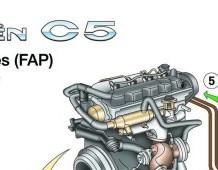Particle filter (PF) C5
Strana 1 od 1
 Particle filter (PF) C5
Particle filter (PF) C5
 | |||||||||||||
| Engines | |||||||||||||
2.2 HDi engine (DW12ATED) and particle filter (PF)
The 2,179 cm3 2.2 HDi unit develops a maximum power output of 98 kW (136 bhp) at 4,000 rpm, with torque of 317 Nm (31.2 m.kg) at 2,000 rpm. The engine uses common-rail direct injection technology (high pressure, 1,350 bars), with combustion chamber geometry designed for maximum fuel / air mixing. Engine design has been optimised to reduce friction and component weight, especially for moving parts. State-of-the-art technologies used on the engine include the variable-geometry turbocharger, an air inlet system with a butterfly choke valve providing variable swirl, two balancer shafts to reduce vibration, and a twin-damped engine flywheel. Camshafts and valves The aluminium cylinder head is fitted with two cast camshafts linked by a drive chain. The camshafts act on 16 valves by means of roller cam followers and hydraulic tappets that take up any play in the system. Variable geometry turbocharger The variable geometry turbocharger provides increased turbocharge pressure at low engine speeds and improved maximum power output at high engine speeds. At low engine speeds, the cross-sectional area of the exhaust gas nozzles driving the turbine is reduced to increase the pressure of the gas hitting the turbine blades with a consequent increase in turbocharge pressure. In contrast, at high engine speeds, the gas nozzles open progressively under the control of the engine control unit to reduce the turbocharge pressure. The engine control unit controls a piston that varies the gas nozzle diameter by means of a pneumatic capsule in response to driver demand (engine speed and load) and data from the pressure sensor located downstream of the air-to-air intercooler. |
| ||||||||||||
 | Variable swirl air inlet The variable swirl system increases the rotational movement of the air in the combustion chamber to ensure that the fuel is completely burned. This ensures high performance and low emissions. The air intake system includes a helical air duct, causing the air flow to rotate into a vortex (swirl), and a tangential duct providing an axial flow. The tangential duct is fitted with a butterfly valve that opens when the engine reaches a preset speed (2,100 rpm at 80 °C) and the injection rate reaches a preset flowrate (40 mg per cycle).The formation of particles at low engine speeds is reduced as a result of the improved fuel / air mixing in the swirl. At higher engine speeds, more air flows through the tangential duct and the swirl is reduced, thereby optimising airflow into the combustion chamber.The piston tops are machined to provide valve clearances, a central dome and the cavity needed to create the swirl. The injectors, located centrally in the combustion chamber, ensure uniform fuel spray. | ||||||||||||
| Twin-damped engine flywheel This flywheel damps out cyclical variations at low engine speeds. These variations in crankshaft acceleration give rise to vibration in the vehicle drive train, especially gearbox rattle. They are a major source of noise at low engine speeds, from 1,200 to 2,400 rpm. The twin-damped flywheel filters out these cyclical variations by increasing gearbox inertia and reducing the stiffness of the damping hub. | |||||||||||||
| The end result is improvement in driving comfort and reduction in noise and vibration. Balancer shafts Two balancer shafts reduce rotating assembly vibration. The masses on the shafts are at their lowest position when a pair of pistons are at top dead centre. The two shafts are driven by the crankshaft and mounted on a unit within the sump. |  | ||||||||||||
| Emission control Exhaust gases are recycled to minimise release of NOx (nitrogen oxides). The emission control subsystem consists of three main components :
Because of the high injection pressure, no pre-heating is required if the engine is started at ambient temperatures above 0 °C. The oil-change service interval is 20,000 km if a semi-synthetic oil such as Total 10W40 is used. | |||||||||||||
| |||||||||||||
| Particle filter (PF) Particles have a diameter of around 0.09 microns and consist mainly of carbon and hydrocarbons. The PF traps these particles and periodically burns them off. Particles burn naturally at approximately 550 °C, but the normal temperature of exhaust gases leaving the manifold is only 150 °C. The particle filter system overcomes this problem in a number of ways :
The particle filter system consists of the following :
The filter is cleaned and the Eolys tank refilled during dealer servicing every 80,000 km. | |||||||||||||
 Similar topics
Similar topics» JEFTINO I DUGOTRAJNO RIJEŠENJE DPF FILTER ( CHEAP AND LONG-TERM Solution OF DPF FILTER )
» Mercedes-Benz "Particle Killer"
» Na koliko se menja filter vazduha
» Filter za vazduh sitnica, koju vozači zaborave
» Kako zamenjati filter za gorivo na AUDI A4 B7 AVANT
» Mercedes-Benz "Particle Killer"
» Na koliko se menja filter vazduha
» Filter za vazduh sitnica, koju vozači zaborave
» Kako zamenjati filter za gorivo na AUDI A4 B7 AVANT
Strana 1 od 1
Dozvole ovog foruma:
Ne možete odgovarati na teme u ovom forumu



















» Zamena kugle do točka C5 bez alata .
» Poništavanje inspekcije Passat B5 (uputstvo+snimak)
» Kemal Malovcic i Juzni Vetar - Idi, voljena, idi
» Neispravnosti na rucici pokazivača pravca i rucici brisača
» Citroen C5 | Održavanje i još mnogo toga
» Kako otkriti šta vam troši akumulator auta ? - Akumulator se prazni preko noći - šta vuče akumulator
» LUPANJE VOLANA PRILIKOM MOTANJA - FORD, MAZDA, FIAT, VW...
» Ubačeni bočni migavci led C5
» Nabavljen nov set za polimerizaciju farova.